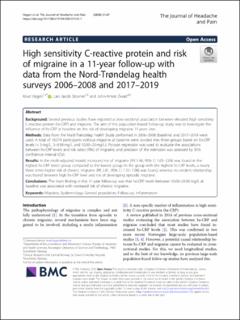| dc.contributor.author | Hagen, Knut | |
| dc.contributor.author | Stovner, Lars Jacob | |
| dc.contributor.author | Zwart, John-Anker | |
| dc.date.accessioned | 2020-08-19T08:34:43Z | |
| dc.date.available | 2020-08-19T08:34:43Z | |
| dc.date.created | 2020-06-11T10:02:42Z | |
| dc.date.issued | 2020 | |
| dc.identifier.citation | The Journal of Headache and Pain. 2020, 21 (67), . | en_US |
| dc.identifier.issn | 1129-2369 | |
| dc.identifier.uri | https://hdl.handle.net/11250/2672933 | |
| dc.description.abstract | Background
Several previous studies have reported a cross-sectional association between elevated high sensitivity C-reactive protein (hs-CRP) and migraine. The aim of this population-based follow-up study was to investigate the influence of hs-CRP at baseline on the risk of developing migraine 11 years later.
Methods
Data from the Nord-Trøndelag Health Study performed in 2006–2008 (baseline) and 2017–2019 were used. A total of 19,574 participants without migraine at baseline were divided into three groups based on hs-CRP levels (< 3 mg/L, 3–9.99 mg/L and 10.00–20 mg/L). Poisson regression was used to evaluate the associations between hs-CRP levels and risk ratios (RRs) of migraine, and precision of the estimates was assessed by 95% confidence interval (CIs).
Results
In the multi-adjusted model, increased risk of migraine (RR 1.46, 95% CI 1.05–2.04) was found in the highest hs-CRP levels group compared to the lowest group. In the group with the highest hs-CRP levels, a nearly three times higher risk of chronic migraine (RR 2.81, 95% CI 1.12–7.06) was found, whereas no evident relationship was found between high hs-CRP level and risk of developing episodic migraine.
Conclusions
The main finding in this 11-year follow-up was that hs-CRP levels between 10.00–20.00 mg/L at baseline was associated with increased risk of chronic migraine. | en_US |
| dc.language.iso | eng | en_US |
| dc.publisher | BMC | en_US |
| dc.rights | Navngivelse 4.0 Internasjonal | * |
| dc.rights.uri | http://creativecommons.org/licenses/by/4.0/deed.no | * |
| dc.title | High sensitivity C-reactive protein and risk of migraine in a 11-year follow-up with data from the Nord-Trøndelag health surveys 2006–2008 and 2017–2019 | en_US |
| dc.type | Peer reviewed | en_US |
| dc.type | Journal article | en_US |
| dc.description.version | publishedVersion | en_US |
| dc.source.pagenumber | 6 | en_US |
| dc.source.volume | 21 | en_US |
| dc.source.journal | The Journal of Headache and Pain | en_US |
| dc.source.issue | 67 | en_US |
| dc.identifier.doi | 10.1186/s10194-020-01142-1 | |
| dc.identifier.cristin | 1814986 | |
| dc.description.localcode | © 2020 The Authors. The article is licensed under a Creative Commons Attribution 4.0 International License, which permits use, sharing, adaptation, distribution and reproduction in any medium or format, as long as you give appropriate credit to the original author(s) and the source, provide a link to the Creative Commons licence, and indicate if changes were made. The images or other third party material in this article are included in the article's Creative Commons licence, unless indicated otherwise in a credit line to the material. If material is not included in the article's Creative Commons licence and your intended use is not permitted by statutory regulation or exceeds the permitted use, you will need to obtain permission directly from the copyright holder. To view a copy of this licence, visit http://creativecommons.org/licenses/by/4.0/. The Creative Commons Public Domain Dedication waiver (http://creativecommons.org/publicdomain/zero/1.0/) applies to the data made available in this article, unless otherwise stated in a credit line to the data. | en_US |
| cristin.ispublished | true | |
| cristin.fulltext | original | |
| cristin.fulltext | original | |
| cristin.qualitycode | 1 | |

